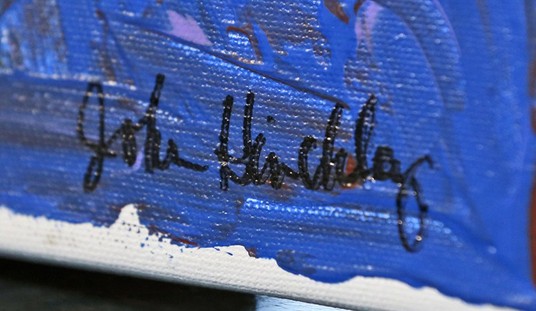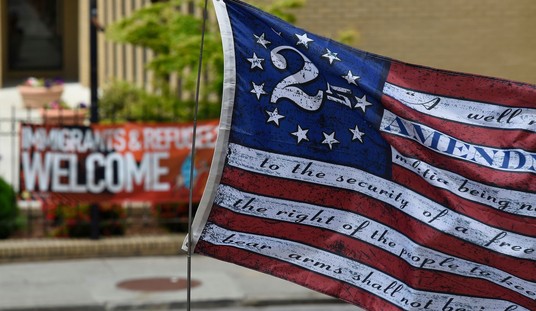
In a editorial posted today called ‘Microstamping’ technology could help police crack down on gun crimes — if the gun lobby allows it, the editorial board of the Times revealed that they want to ban all firearms in the United States by requiring them to be equipped with a fantasy technology that does not exist in a viable form.
When someone shoots up a neighborhood with a semiautomatic weapon, the shooter usually leaves evidence behind — not only the bullets fired, but also the spent casings ejected from the gun as a fresh round loads. Ballistics experts can match distinctive marks the firing process leaves on the bullets and the casings against fresh samples fired from a gun that investigators believe may have been used in the crime. But first, of course, they must have the gun.
But there’s another technological solution that can help investigators connect spent casings to the gun that fired them: microstamping, a process in which a gun’s firing pin and what’s known as its breech face stamp an identifying code on the casing as the gun is fired. And under the California Crime Gun Identification Act, a 2007 state law that finally went into effect in 2013, all new semiautomatic handguns sold in California must be equipped with microstamping technology so that recovered casings can be traced to the gun’s last recorded buyer through the state’s database of gun sales.
That doesn’t necessarily mean the gun buyer was the shooter, of course, but it gives investigators a trail to pursue. And it also makes it easier for investigators to link casings from different crime scenes to the same gun, discerning patterns and connections that might otherwise be missed.
But only California requires microstamping technology today, which has led gun manufacturers to simply stop selling new semiautomatic handgun models in the state. That has effectively negated California’s law; according to the state Attorney General’s office, there are no new models with microstamping technology on its list of handguns certified as safe for sale. Clearly, a nationwide requirement is needed to compel gun makers to adopt the identifying technology. U.S. Rep. Xavier Becerra (D-Los Angeles) and Sen. Edward M. Kennedy (D-Mass.) proposed just such a law in 2008, but the measure died in committee.
Oh, California! Oh, humanity!
The editorial board of the Times—which has all the intellectual diversity of a Politburo meeting—simply assumes that the firearms industry is recalcitrant, and refusing to sell microstamped firearms in California out of spite. In their myopic world view, firearms manufacturers are the epitome of evil. They truly believe that manufacturers don’t want to implement a technology that would put criminals behind bars, because… um… well…
Let’s look at this with a shred of rationality, shall we?
- Gun makers are forced to drop out of the firearms market in California (the largest singer state market in the nation) due to requirements of the Crime Gun Identification Act
- ?
- Profit
Where have I seen this logic before? Oh, yes…
Here’s a very short synopsis of why gun companies aren’t microstamping firearms.
- The technology to produce microstamping on a commercial scale does not exist. Period.
Yes, you read that correctly.
According to the inventor of micro-stamping and other experts, it isn’t a commercially viable technology.
Microstamping is not ready for use as a crime solving technology. That’s the conclusion of a peer reviewed study published in the scientific journal of forensic firearms examiners based on work conducted by a team of experts and funded by the U.S. Department of Justice. The patent holder of the technology, Mr. Todd Lizotte, was himself involved in the research that concluded “…legitimate questions exist related to both the technical aspects, production costs, and database management associated with microstamping that should be addressed before wide scale implementation is legislatively mandated.”
As the journal article said, “…microstamping involves more than just ‘blasting a number’ onto a firing pin using a laser, which to the layman may seem how the technique works.” Instead, the process would have to be optimized for each model of firearm made by all manufacturers, a costly and time-consuming process that threatens the employment of thousands in the firearms industry.
A follow-up study, co-authored by Mr. Lizotte, the holder of the microstamping patent, conceded several major problems with the technology that occur even in an “optimized” situation. Because the alphanumeric codes are frequently illegible, the study attempted to use expensive Scanning Electron Microscopes (SEM) to read the corresponding gear codes also imprinted on fired cartridges. The gear codes are meant to contain the same information as the alpha-numeric code. The study concluded that even with advanced technology, “a full gear code appears to be rare and dependent on the weapon that made the impression.”
California lawmakers may as well have passed laws regarding the use of phasers from Star Trek, another technology that doesn’t exist.
But let’s assume for the sake of argument let’s pretend that microstamping is real, and not fantasy, just to see the absurdity of the Crime Gun Identification Act play out.

This in example of a firing pin, scaled larger than it actually is in real life.
If microstamping was an real, commercially viable technology, the gear code would be engraved on the rounded part of the pin that contacts the primer (left above) to leave an impression on the primer when the pin strikes the primer. The shell casing would then be ejected with the (theoretical) code left on the primer.
Here’s reality.
An average person can take a firing pin out of just about any firearm in less than five minutes.
He can then obliterate the microstamp with a common shop grinder in less than five seconds, or if he wants to manually sand it down, it might take 2-3 minutes. The microstamp is permanently removed from the part and the gun is reassembled in less than 15 minutes. It’s much easier than defacing a serial number which professional criminals already do with great ease.
-OR-
A person can simply buy a new firing pin on any number of web sites or in retail stores for $6.50 (up to $40 or so for other models). They are common small parts, easily swapped from gun to gun.
There are already hundreds of millions of them in the country.
They are not serial numbered parts that are controlled.
Instead of defacing the microstamped gear code, they’ll just swap out the part.
-OR-

A criminal plotting a shooting needs to only “salt” the crime scene with one or more shell casings picked up from the ground at any firing range to send the police on a wild goose chase. Crime labs will be slammed with false leads. Detectives will have to bring in bewildered gun owners who have nothing to do with the shooting for interrogation, wasting time and money as officers have to rule them out as suspects.
-OR-
The criminal can obtain two of the same model of firearms or two compatible models, and swap the firing pins, so that the rifling on the bullet and the microstamping gear code left on the primer suggests two different guns were used.
-OR-
The simple fact of the matter is that that firing pin to primer is repeated metal-to-metal contact.
How many rounds fired will it take for the gear code imprinted to be hammered into illegibility?
A dozen? A hundred? A few hundred?
The reality of the matter is that these gear codes are going to be incredibly fragile due to their tiny size on small parts. A single trip to the range or a gun class will to see the gear code destroyed just through normal use in the course of a weekend.
As the average “time to crime” for a handgun in the United States is nearly eleven years, that means that the odds of a crime gun having a functional microstamped gear code on it are between slim and none even in a fantasy world where they could even be produced and managed, which the inventor himself concedes does not exist.

California’s microstamping law was never about solving crimes
For those of us that actually know a few things about firearms, microstamping makes about as much sense as putting serial numbers on toilet paper squares or regulating unicorn farts.
The California Democrats who pushed the Crime Gun Identification Act knew that microstamping is a commercial impossibility with existing technology. They also were aware of the many ways in which this fantasy technology would fail or actually complicate the lives of law enforcement officers, and actually reduce the likelihood of getting convictions, when they pushed for the law.
So why would California Democrats force through a law mandating a technology that doesn’t exist in a viable form, and which can’t work in the real world?
That’s simple: by requiring a technology that doesn’t exist, they have created the circumstance that will eventually ban all handguns in California.
When manufacturers make any change to a handgun, no matter how small, that firearm is no longer eligible to be sold in California. Dozens of models fall off the approved handgun list every year.
If you view the implementation of an unworkable microstamping law as the intentional sabotage of the California handgun market by a rogue, liberty-oppressing government, you would be right.
28 handgun models in common use were removed from the handgun roster by the California Department of Justice since January 28, 2014, and are now unavailable to gun buyers, reports Calguns. Of those, 22 are manufactured by Smith & Wesson, Inc.
However, California gun owners have reason to be optimistic, say the groups. In a major development, firearm manufacturers Smith & Wesson and Sturm, Ruger & Co., Inc., have joined handgun maker Glock, Inc., in support of a federal Second Amendment civil rights lawsuit seeking to overturn the handgun regulation scheme commonly known as the “handgun roster.”
“SAF will be eternally grateful for the timely support from all three companies, which we believe strongly reinforces our case,” said SAF founder and Executive Vice President Alan M. Gottlieb.
In one of two new declarations filed with the trial court, Smith & Wesson CEO James Debney stated that “as a result of the microstamping requirement, Smith & Wesson is losing its ability to sell many of its semi-automatic handguns in California, as its handguns are forced off the roster [by the California Department of Justice].”
The lawsuit, filed by Second Amendment Foundation and The Calguns Foundation, seeks to overturn the entire roster scheme and restore the full handgun market to California consumers. The case is helmed by noted civil rights attorneys Alan Gura of Alexandria, Virginia, Donald Kilmer of San Jose, California, and Jason Davis of Mission Viejo, California.
California Attorney General Kamala Harris went for all of the proverbial marbles when she implemented a microstamping requirement that cannot be met by manufacturers of semi-automatic pistols. As a direct result of the technically non-feasible scheme, no new semi-automatic pistol designs can be approved for sale in California, while the state is culling an average of 59 semi-automatic pistols from the approved list every year, and have been for the past decade. The obvious goal is the complete destruction of the new semi-automatic pistol market in California, which at this pace will be complete in a decade.
Legendary handgun manufacturer Colt has just one handgun left for sale in California once the existing supply of older guns runs out. Soon, that, too may be gone.
The Los Angeles Times editorial board has called for forcing this non-existent technology on the rest of the nation, and not just for handguns, but for shotguns and rifles as well.
There is only one reason to force this on the rest of the nation.
The editors of the Los Angeles Times want all guns banned.
They just lack the integrity to say so plainly.








Join the conversation as a VIP Member